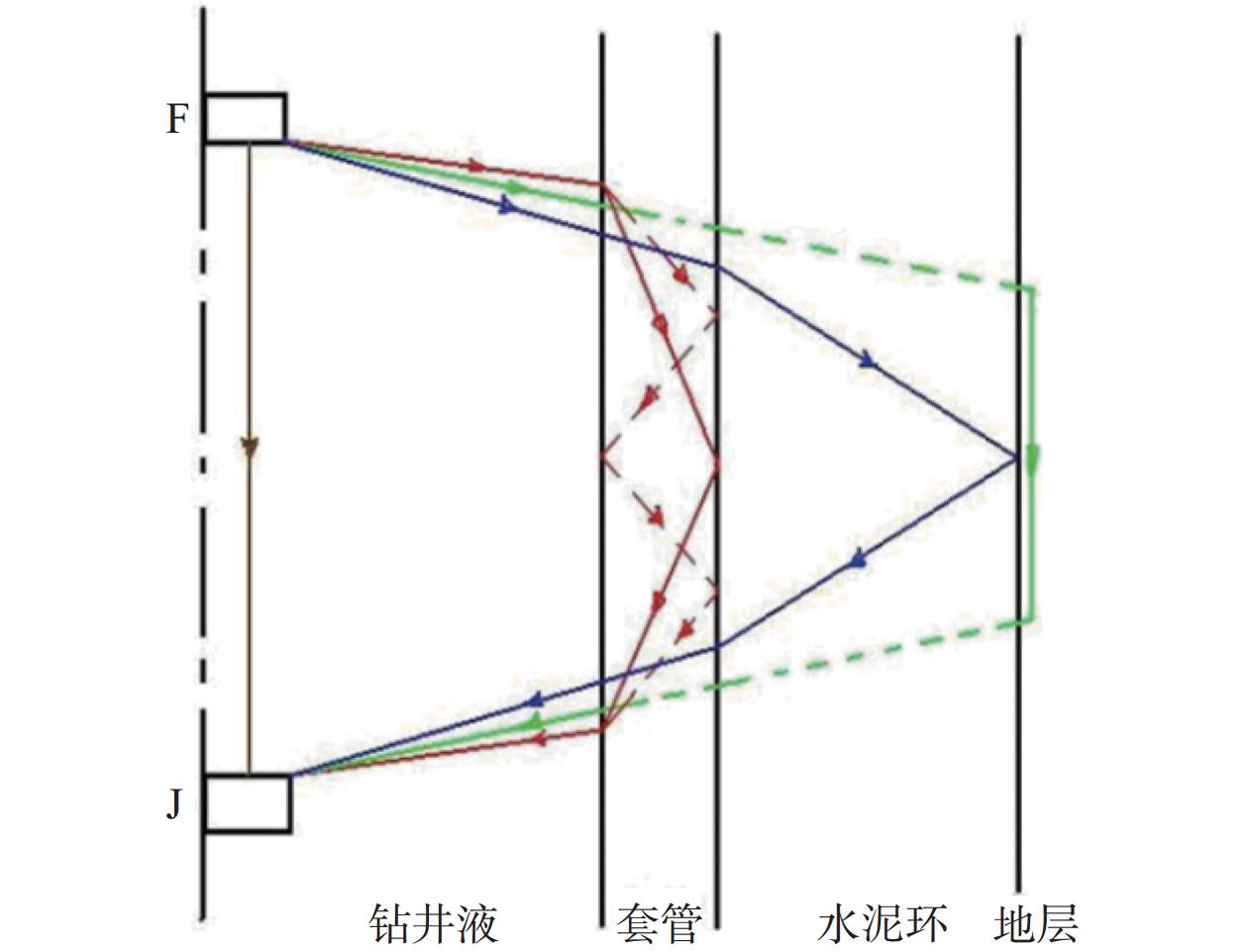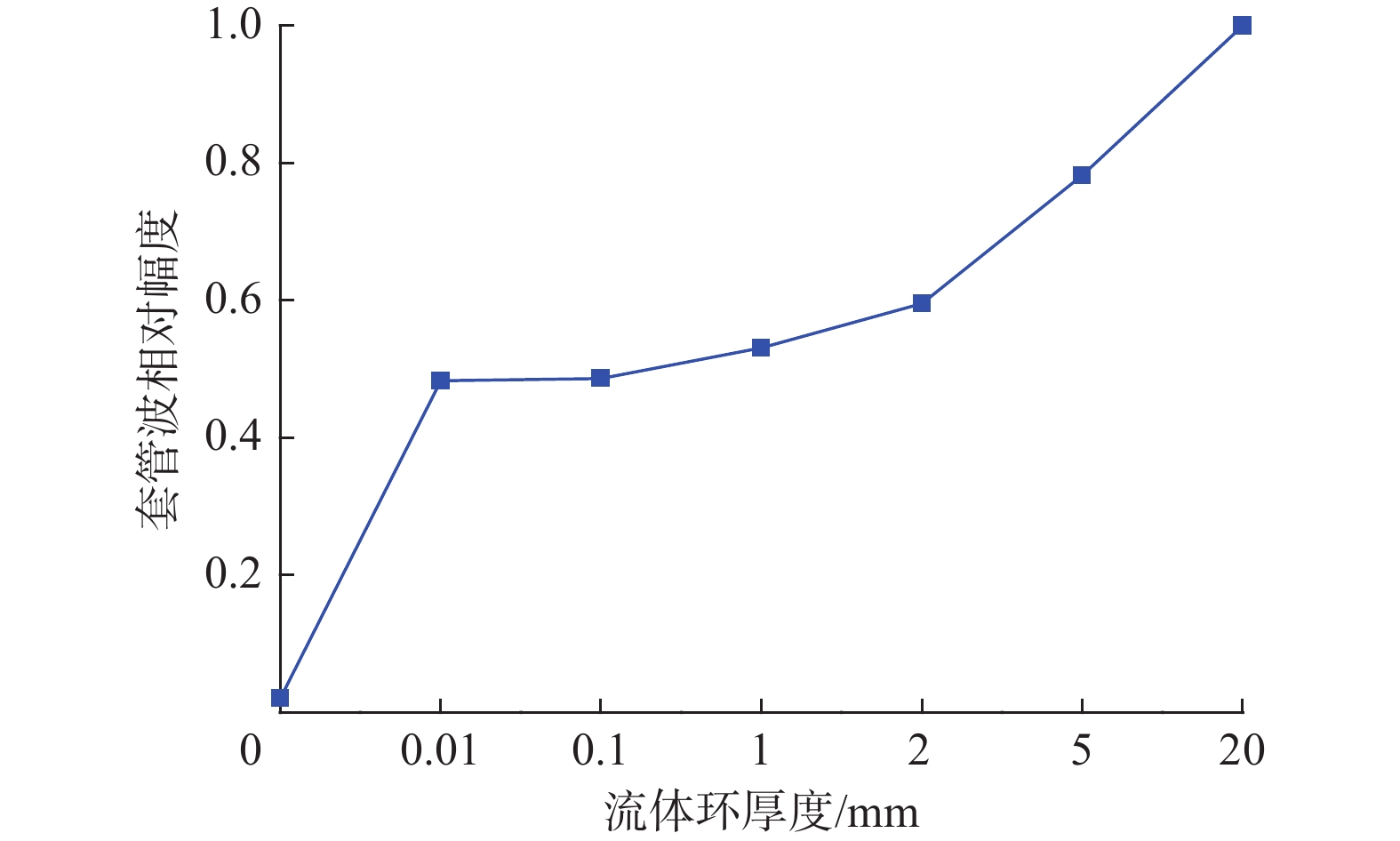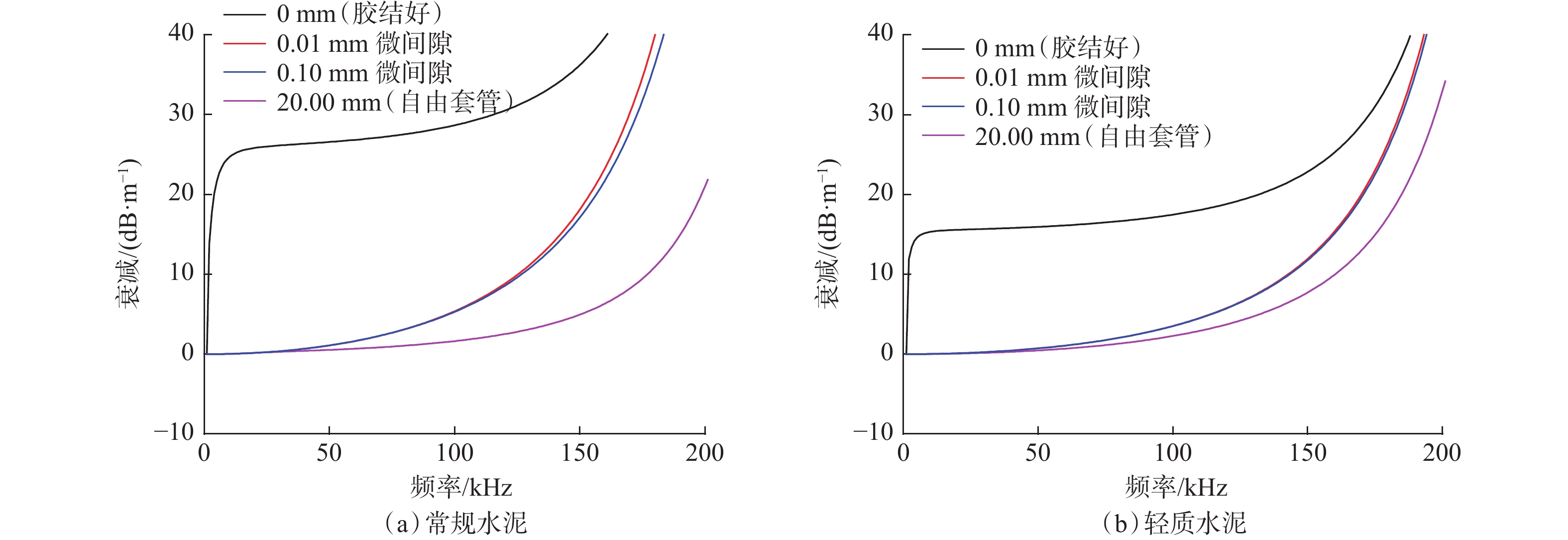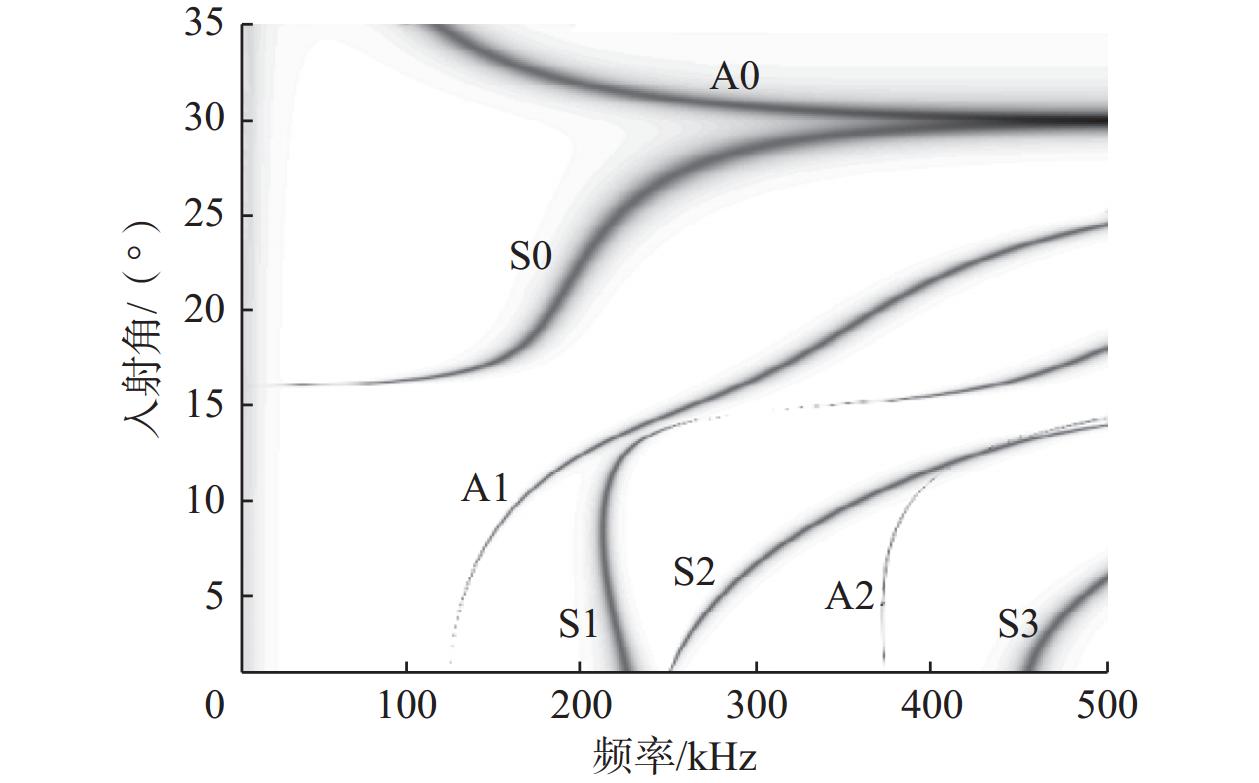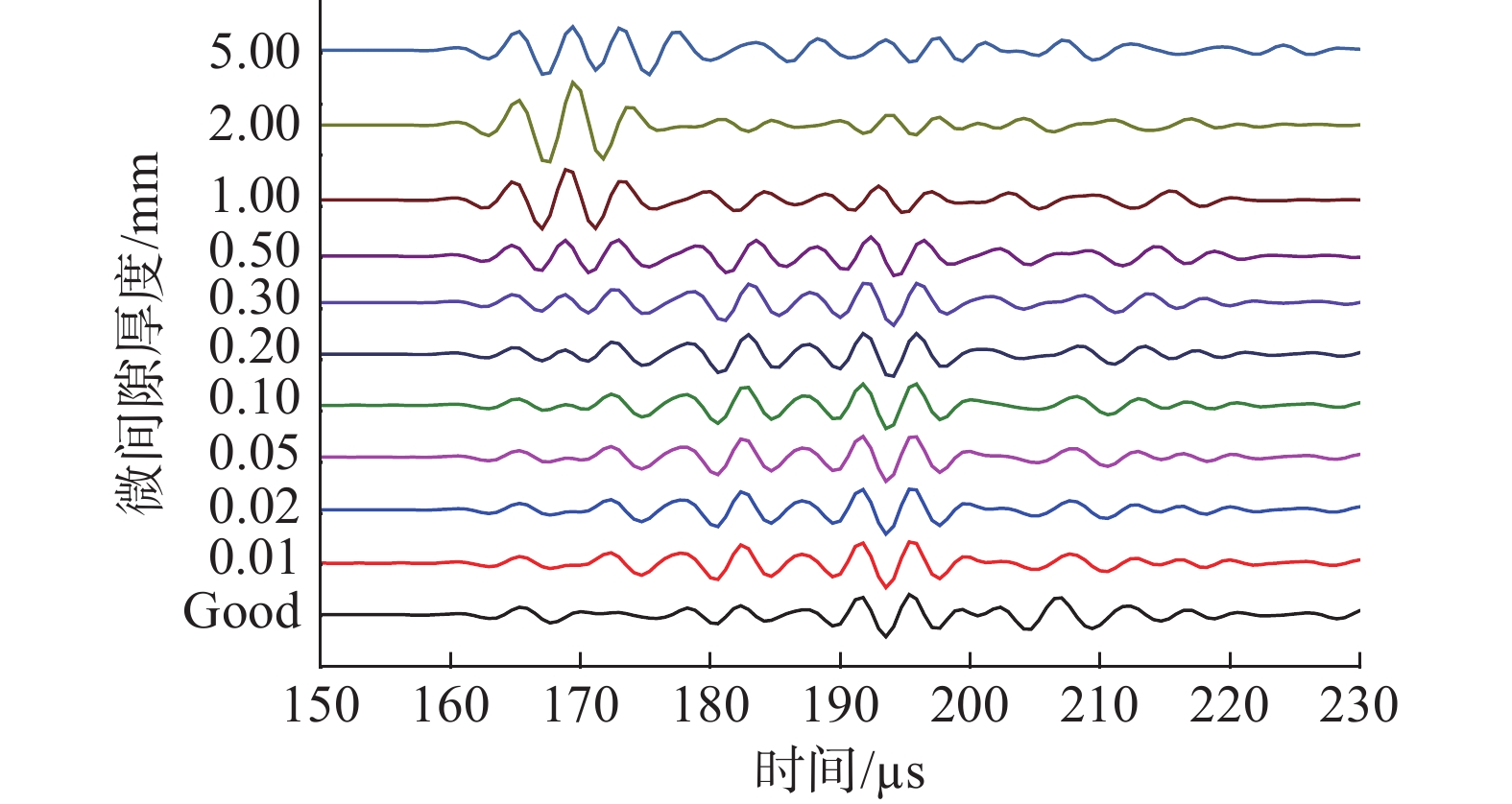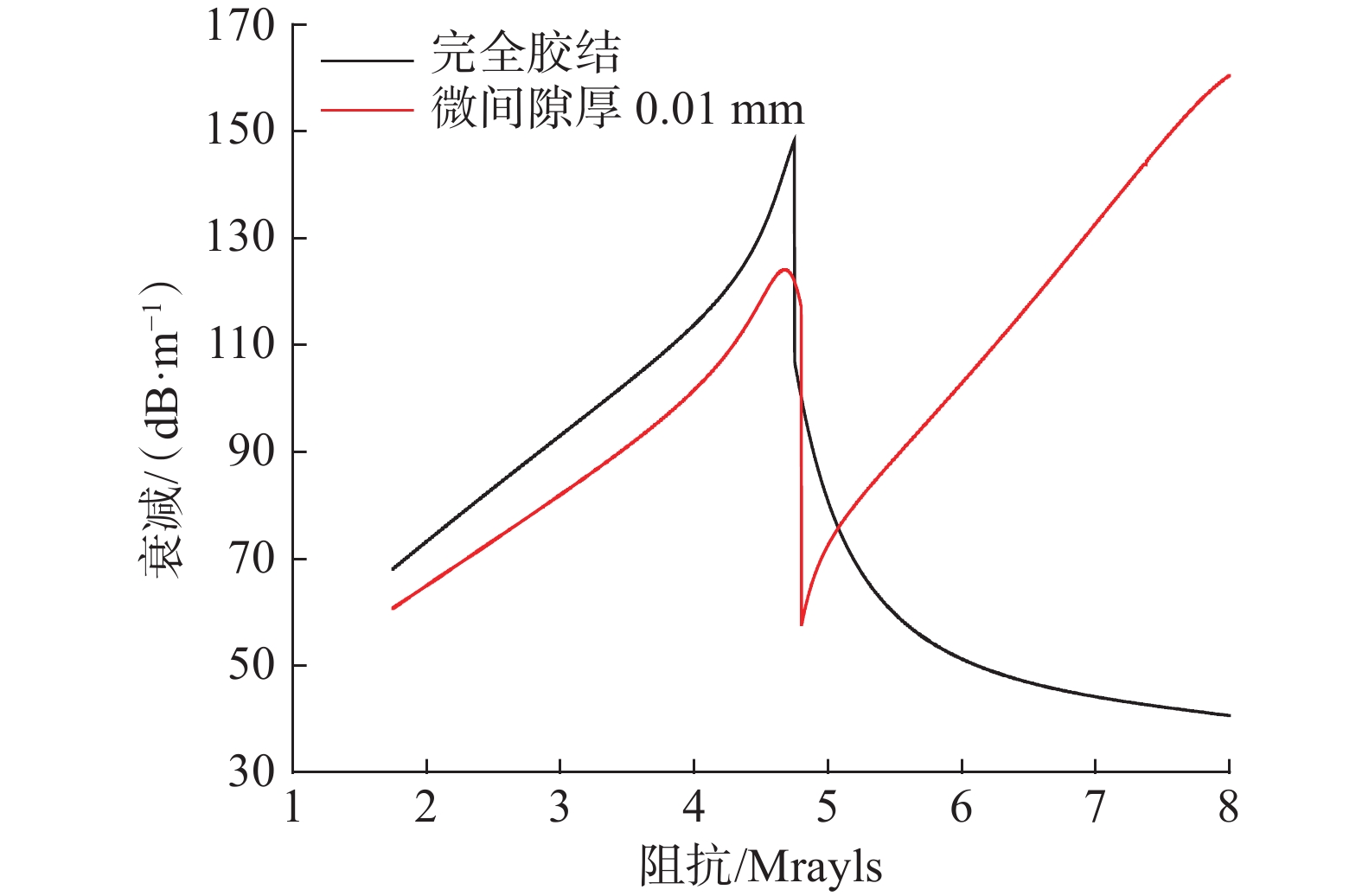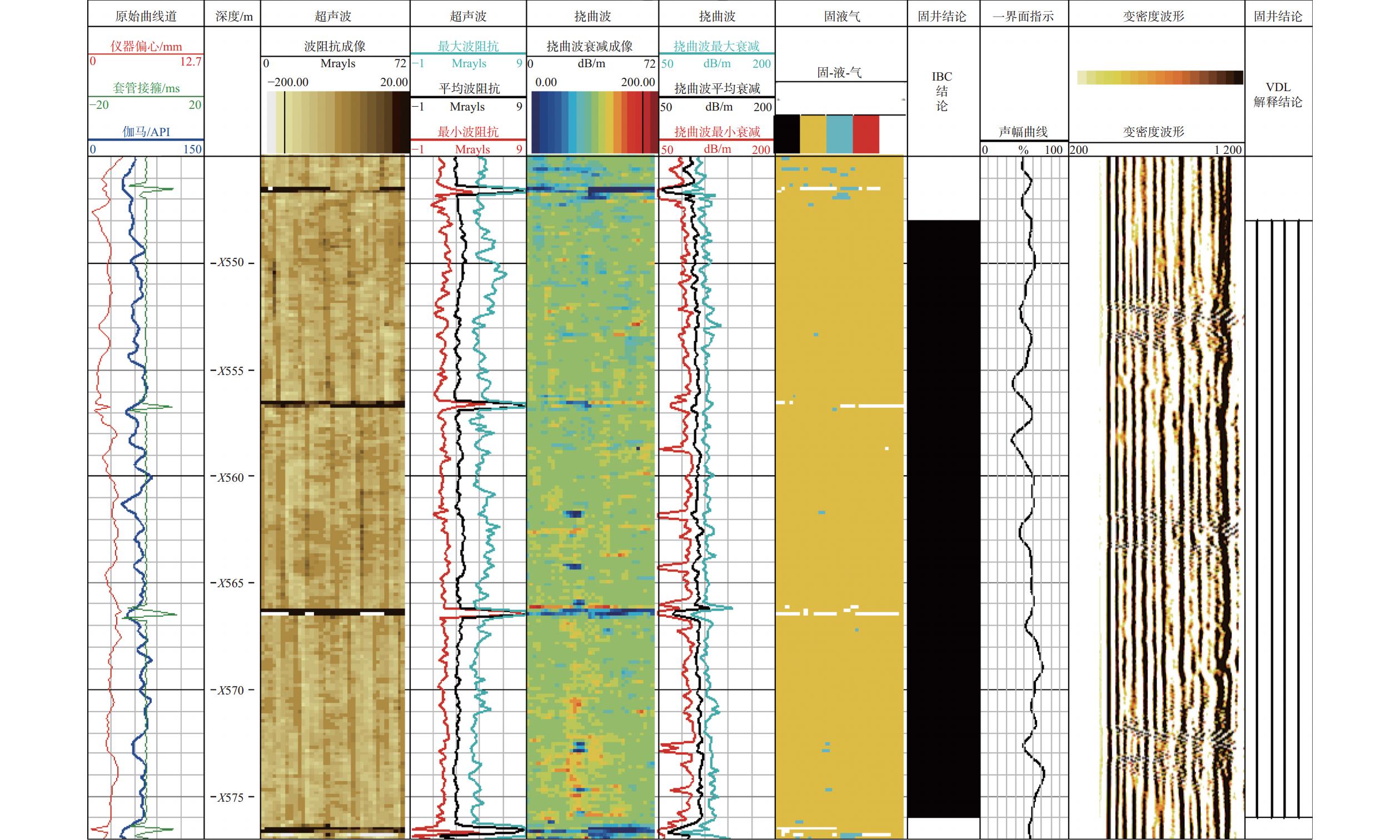Identification Method of Microannulus Based on IBC and CBL/VDL Logging
-
摘要:
为了明确微间隙厚度对不同测井仪器固井质量评价结果的影响,研究了CBL/VDL测井的套管波、IBC激发的共振波与挠曲波对微间隙的响应特征,分析了套管与水泥环间微间隙、水泥浆密度等因素对3种模式波的影响规律。分析表明,CBL/VDL测井的套管波对微间隙一直敏感,幅度随微间隙(充液微间隙)厚度增加而增大,厚度0.01 mm的微间隙也会使套管波相对幅度达到30%~50%,此响应结果导致判定水泥胶结差;共振波幅度对厚度小于0.10 mm的微间隙不敏感;挠曲波在套后胶结低阻抗水泥时,衰减稍有降低,但在套后耦合高阻抗水泥(一般指常规水泥和加重水泥)时,微间隙会使衰减明显增大,可见微间隙导致挠曲波的衰减均是高值,在气液固相态识别时会判定为套后介质是固体水泥,因此联合CBL/VDL和IBC测井结果可识别井下微间隙井段。现场多口井试油结果表明,CBL套管波幅度高、但挠曲波衰减值也高的井段在试油过程中均显示了较好的水泥封隔能力,表明该测井结果是微间隙的响应特征。基于IBC和CBL/VDL测井的微间隙识别方法避免了传统的井筒加压测井方式,现场应用效果较好,具有较好的推广应用价值。
Abstract:To accurately study the influence of microannulus thickness on the evaluation of cementing quality by different logging instruments, this study analyzed the response characteristics of CBL/VDL logging casing waves, IBC-induced resonance waves, and flexural waves to the presence of microannulus. The study focused on how the microannulus between the casing and cement sheath as well as the density of the cement slurry, impacts these three wave modes. The findings reveal that the casing wave in CBL/VDL logging is consistently sensitive to the presence of microannulus, with amplitude increasing as the microannulus thickness (fluid-filled) grows. A microannulus as thin as 0.01 mm can cause the relative amplitude of the casing wave to reach 30%–50%, leading to an assessment of poor cement bonding. The resonance wave amplitude, however, is not significantly affected by microannulus thinner than 0.01 mm, and the attenuation of the flexural wave only slightly decreases when low-impedance cement is cemented behind casing. In contrast, when high-impedance cement (generally conventional cement and heavy cement) is coupled, the presence of microannulus markedly increases attenuation, causing the flexural wave to reach a high attenuation value. In gas-liquid-solid phase identification, the medium behind the casing is likely to be identified as solid cement, making the combination of CBL/VDL and IBC logging results effective for identifying microannulus intervals. Field oil test results from multiple wells show that wells with high CBL casing wave amplitudes and high flexural wave attenuation values consistently demonstrate better cement sealing capabilities, confirming that these logging responses are characteristic of microannulus. This method of microannulus identification, based on IBC and CBL/VDL logging avoids the traditional wellbore pressure logging method and obtains a good application effect, and it is worthy of promotion and application.
-
Keywords:
- micro annulus /
- flexural wave /
- casing wave /
- attenuation
-
塔里木油田2022年完钻超深井(6 000 m以上)占比近90%,固井质量是超深井建井的关键环节,也是保证油气井生产寿命的关键所在,对油气田勘探开发效益和产能建设非常重要。超深井由于裸眼段长,固井段温度、压力差异大,地层流体更为复杂,微间隙普遍存在会造成声幅值变高对固井质量评价产生误导,进而可能影响试油作业方案制定。塔里木油田由于存在多套易漏地层,广泛使用低密度水泥浆,低密度水泥浆会使CBL值升高[1–7],若同时存在微间隙,无法判断是由于微间隙造成的声幅升高还是存在水泥浆窜槽。针对上述难题,塔里木油田对“三高”气井生产套管段实行CBL/VDL和IBC联测的测井方案,以实现固井质量的精确评价。常规声波固井质量评价方法(如水泥胶结测井(CBL)和声波变密度测井(VDL))采用套管波幅度评价水泥的胶结状况,其物理原理是水泥和钻井液的声阻抗差异大,套后胶结水泥时套管波幅度小,若是自由套管,则声幅值明显增大,但声幅测井只能反映井周平均情况;套后胶结低密度水泥时,由于其声阻抗小于常规水泥,有时与井内钻井液声阻抗相当,这会使利用声幅变密度测井评价低密度水泥时的动态响应范围明显变小,灵敏度降低。另外,套管与水泥环之间存在微间隙,但未形成有效连接时,应认为胶结质量好,常规声幅测井易产生误判[8–10]。斯伦贝谢的套后成像测井仪(IBC)是通过斜入射在套管中激发挠曲波与垂直入射激发共振波2种方式联合测井,可较好地识别套管外胶结介质的相态,特别是挠曲波明显提高了套后胶结轻质水泥时固井质量评价的灵敏度[11]。基于此,笔者通过研究CBL套管波、挠曲波及共振波等3种模式波在不同密度水泥、不同微间隙厚度和类型条件下的响应差别,建立了超深井微间隙识别和评价方法,大幅提高了固井质量解释符合率。
1. VDL和IBC测井原理
1.1 VDL测井原理简述
常用的CBL/VDL测井仪采用单发双收声系采集水泥胶结信息,源距分别为914.4和1 524.0 mm,发射频率为20 kHz。其中源距914.4 mm接收换能器采用固定门采集套管波E1波峰幅度(见图1),固定门为在套管尺寸已知后确定的时间窗,取记录波形中此时间窗内的声波峰值,此峰值经过刻度后就是声幅值;源距1 524.0 mm接收换能器采集每一深度点的声波全波列信息,以变密度方式(VDL)记录,用于评价水泥胶结质量。CBL能反映套管−水泥环之间第一界面的胶结情况, 一般认为CBL值越大,第一界面胶结越差;CBL值越小,第一界面胶结越好。VDL不仅能反映第一界面的胶结情况, 而且能反映水泥环−地层之间第二界面的胶结情况(见图2,图中的F和J分别表示发射换能器和接收换能器) 。
1.2 IBC测井原理
IBC套后成像仪(Isolation Scanner)是斯伦贝谢公司用于固井质量及套损评价的仪器[11],它通过结合2种声波技术:经典的脉冲回波技术和最新的挠弯曲波(Lamb波)成像,适用于评价各种类型水泥,其测量原理如图3所示。脉冲回波技术通过井壁反射波幅度对套管内壁的粗糙度进行成像,井壁反射波到时可反演仪器偏心,套管共振波的频率和衰减可分别用于计算套管厚度和反演套后水泥的声阻抗(见图3(a))。脉冲回波测量时换能器辐射的声波垂直入射到套管内壁,套后成像测井仪器的另外一种测量方式是探头辐射的声波斜入射到套管内壁,在套管中激发挠曲波(Lamb波),沿着套管传播的挠曲波(Lamb波)还会向套管两侧辐射声波,利用2个接收换能器记录泄漏的声波信号计算挠曲波(Lamb波)的衰减(见图3(b))。超声回波和挠曲波(Lamb波)的测量声系在仪器中是背靠背放置的。仪器在井下工作时测量声系通过旋转扫描实现对整个环向的套后介质成像,一般旋转一圈采集36个方位的波形数据。脉冲回波测量反演的声阻抗和挠曲波衰减交会识别套后介质相态(见图3(c)),从而实现套后介质气液固成像。
2. CBL/VDL和IBC对微间隙的响应特征
2.1 CBL/VDL数值模拟
采用经典的弹性波传播理论模拟套管与水泥之间不胶结时,是在套管与水泥之间加入一层流体环(见图4)。
流体环的存在阻断了套管与水泥之间的轴向振动(相对于界面为切向振动),即使流体环为厚度0.01 mm的微间隙,也会使套管波幅度明显增强。套管波相对幅度(各胶结模型下首波的第一个正峰与自由套管模型下首波的第一个正峰的比值)随流体环厚度变化的趋势如图5所示,可以看出,微间隙厚度为0.01 mm时,套管波的幅度已接近自由套管状态下(套管与地层间充填水)套管波幅度的50%。
套管后胶结常规水泥和轻质水泥时,套管波的衰减曲线如图6所示。由图6可知,套管后有微间隙存在时,套管波的衰减接近自由套管状态的衰减值,说明CBL/VDL测井对微间隙非常敏感,微间隙的存在会使套管波幅度明显增大,衰减降低,套管后耦合任意类型水泥时的响应特征都是一致的[8–10]。当井下实际存在厚度较小微间隙时,套管与水泥环之间会存在固体颗粒,有时仍可观测到地层波。如图7所示,L1井在图示井段采用密度1.88 kg/L常规水泥固井,第一次测井时钻井液密度为1.52 kg/L,第二次测井时钻井液密度为1.80 kg/L,2次测井采用同一只测井仪器,2次测井时间间隔24 h。该井X 000~X 045 m段第一次测井平均声幅值(第3道黑色曲线)在40以上,地层波也较为明显;但第二次测井平均声幅值(第3道红色曲线)出现明显下降,声幅平均值在10以下,地层波幅度也明显增大,与裸眼井声波时差曲线对应关系更好。这说明该段固井质量第一界面存在较小的微间隙,且存在固体颗粒,所以第一次测井时虽然声幅值较高,但地层波依然可见。
2.2 IBC中的共振波和挠曲波的响应特征
S. Zeroug等人[11]提出了通过控制声束入射角的方式来有效激发不同模式波的方法。图8所示为理论计算的不同角度入射时在浸水钢板可激发的模式波的频散曲线,可见在垂直入射时,套管中主要激发的是高阶对称模式S1、S2及S3等;入射角大于30°时,激发的是套管中的挠曲波[12]。
CBL/VDL测井对微间隙敏感,但是垂直入射下的套管共振回波对微间隙不敏感。图9所示为快速水泥无地层模型下计算的共振波幅度随套管与水泥间流体层厚度的变化趋势,从右侧的放大图可见,微间隙厚0.01~0.10 mm时,对共振波基本无影响,这与斜入射下激发的挠曲波的响应规律不同(见图10),对于快速水泥(高阻抗水泥),一旦出现厚度0.01 mm的微间隙,挠曲波的幅度明显下降;随着微间隙厚度增大,其下降幅度还会逐渐增大;从水泥与地层界面的反射波幅度与直达波的幅度变化趋势正好相反,说明沿着套管传播的挠曲波泄露的能量越大,衰减越快,幅度越低,则从水泥环外界面的反射波幅度就越大。
套管后胶结慢速水泥(轻质水泥或低密度水泥)时计算的共振波幅度随套管与水泥间流体层厚度的变化如图11所示。由图11(b)可知,厚度为0.01~0.10 mm的微间隙对共振波基本无影响,流体环厚度继续增大,共振波的幅度明显增大。
套管后耦合轻质水泥时,若微间隙厚度小于0.30 mm,其对挠曲波幅度变化的影响很小,但从水泥−地层界面反射的SS波幅度减小明显,P/S或S/P波幅度变化不大;随着微间隙厚度增加,挠曲波的幅度增加明显,衰减明显减小(见图12)。
水泥胶结良好和存在微间隙时,挠曲波衰减率随套后水泥阻抗的变化规律如图13所示。从图13可以看出,胶结良好时,随着水泥声阻抗增大,衰减逐渐增大,阻抗值达到4.7 Mrayls时衰减取得最大值;随着水泥声阻抗继续增大,衰减急剧下降,这与较大声阻抗水泥的纵波速度大于套管挠曲波相速度时只向水泥环辐射横波有关。挠曲波的衰减与水泥速度之间的复杂关系,即相同的衰减率对应套管外不同的声阻抗耦合介质,再次说明不能像SBT测井方法仅依赖挠曲波的衰减来评价水泥环第一界面的胶结质量,应建立声衰减−声阻抗图版来评价固井质量。
套管与水泥环之间微间隙厚度小于0.10 mm、水泥阻抗小于4.7 Mrayls时,衰减稍有降低;水泥阻抗大于4.7 Mrayls时,微间隙的出现降低了套后介质的等效声阻抗,使挠曲波的衰减急剧增大。因此,联合CBL/VDL和IBC测井数据可确定井下是否有微间隙存在,CBL高值或VDL变密度图中套管波幅度强,但IBC测量的衰减值相对较高是固体的响应特征,则可判断井下有微间隙存在[13–16]。
3. 实例分析
H1井是塔里木油田H区块一口开发井,图14中井段采用密度1.88 kg/L的常规水泥固井。根据裸眼井测井资料,X 076.50~X 078.50 m井段解释为油层,X 088.50~X 097.00 m井段解释为水层。为精细评价固井质量,目的层固井后同时采集了CBL/VDL和IBC资料。X 078.50~X 088.50 m井段第9道的声幅值为30~45,表明第一界面胶结不好,VDL显示地层波也不明显,综合评价为差,所以射孔后可能导致窜槽。但从IBC测井资料来看,声阻抗值高,挠曲波衰减大,SLG成像图显示全部为固体填充,所以X 078.50~X 088.50 m井段可能存在液态微间隙,导致声幅值高,对油水层来说并不影响水泥环封隔能力。后期对X 076.60~X 078.40 m井段射孔,产油量53.0 m3/d,不含水,未发生窜槽,验证了微间隙识别方法的准确性。
塔里木油田M区块M1井某井段采用密度为1.38 kg/L的低密度水泥固井,为精细评价固井质量,固井后采集了CBL/VDL和IBC资料(见图15)。第9道的声幅值高达50~60,指示第一界面胶结不好,且VDL上接箍明显,地层波不可见,综合评价为胶结差;但从IBC测井资料看,波阻抗平均在4 Mrayls左右,挠曲波衰减平均在120 dB/m左右,指示第一界面胶结良好,套管附近为固体填充。综合CBL/VDL和IBC资料,判断X 545~X 580 m井段存在液体填充的微间隙,不影响水泥环封隔性。X 550~X 575 m井段采用封隔器进行射孔验窜作业,不窜,证明水泥胶结好,CBL高值是由于液体填充微间隙造成的。
4. 结 论
1)CBL/VDL测井时激发的套管波沿套管传播时与套管后物质主要以剪切刚度耦合,因此即便是厚度0.01 mm的微间隙,也会使套管波衰减明显降低,接近套管后为流体时的响应特征。因此,CBL/VDL测井时若声幅值出现大段异常高值,可能存在窜槽或者微间隙,可结合IBC测井进一步验证。
2)IBC测井在套管中产生的挠曲波与套管后物质主要以法向刚度耦合,使套管后胶结轻质水泥时的挠曲波对微间隙不敏感,套管后耦合常规水泥时的微间隙会导致挠曲波的衰减明显增强。因此,CBL/VDL和IBC测井二者结合,当CBL套管波幅度较高时,若挠曲波的衰减较高,则可判定为套管与水泥环之间存在微间隙。
-
-
[1] 谢关宝. 轻质水泥浆固井质量测井评价标准构建[J]. 石油钻探技术,2022,50(1):119–126. doi: 10.11911/syztjs.2022015 XIE Guanbao. Establishment of logging evaluation criteria for the cementing quality of low-density cement slurries[J]. Petroleum Drilling Techniques, 2022, 50(1): 119–126. doi: 10.11911/syztjs.2022015
[2] 吴天乾,宋文宇,谭凌方,等. 超低密度水泥固井质量评价方法[J]. 石油钻探技术,2022,50(1):65–70. doi: 10.11911/syztjs.2021111 WU Tianqian, SONG Wenyu, TAN Lingfang, et al. Evaluation method for cementing quality of ultra-low-density cement[J]. Petroleum Drilling Techniques, 2022, 50(1): 65–70. doi: 10.11911/syztjs.2021111
[3] 章成广,李维彦. 低密度固井质量声波测井评价方法研究[J]. 石油天然气学报,2005,27(4):450–454. doi: 10.3969/j.issn.1000-9752.2005.04.015 ZHANG Chengguang, LI Weiyan. Methods for evaluating low density cementing quality by acoustic logging[J]. Journal of Oil and Gas Technology, 2005, 27(4): 450–454. doi: 10.3969/j.issn.1000-9752.2005.04.015
[4] 江万哲,章成广,陈义群. 低密度水泥固井对套管波幅度的影响及其校正方法[J]. 石油天然气学报,2008,30(5):77–80. doi: 10.3969/j.issn.1000-9752.2008.05.018 JIANG Wanzhe, ZHANG Chengguang, CHEN Yiqun. The casing wave amplitude impaction and method for correcting low density cementing[J]. Journal of Oil and Gas Technology, 2008, 30(5): 77–80. doi: 10.3969/j.issn.1000-9752.2008.05.018
[5] 步玉环,宋文宇,何英君,等. 低密度水泥浆固井质量评价方法探讨[J]. 石油钻探技术,2015,43(5):49–55. BU Yuhuan, SONG Wenyu, HE Yingjun, et al. Discussion of a method for evaluating cementing quality with low-density cement slurries[J]. Petroleum Drilling Techniques, 2015, 43(5): 49–55.
[6] 田鑫,章成广,毛志强. 低密度水泥固井质量评价方法研究[J]. 石油钻探技术,2006,34(6):36–38. doi: 10.3969/j.issn.1001-0890.2006.06.012 TIAN Xin, ZHANG Chengguang, MAO Zhiqiang. An evaluation method for cementing operations with light weight cement[J]. Petroleum Drilling Techniques, 2006, 34(6): 36–38. doi: 10.3969/j.issn.1001-0890.2006.06.012
[7] 李韶利. 1.15 g/cm3超低密度水泥浆的研究与应用[J]. 钻井液与完井液,2020,37(5):644–650. LI Shaoli. Study and application of an ultra-low-density cement slurry[J]. Drilling Fluid & Completion Fluid, 2020, 37(5): 644–650.
[8] 步玉环,沈兆超,王银东,等. 固井第一界面微环隙对声波传播规律的影响[J]. 石油钻探技术,2014,42(1):37–40. doi: 10.3969/j.issn.1001-0890.2014.01.007 BU Yuhuan, SHEN Zhaochao, WANG Yindong, et al. Effect of microannulus on sonic wave propagation at first cementing inter-face[J]. Petroleum Drilling Techniques, 2014, 42(1): 37–40. doi: 10.3969/j.issn.1001-0890.2014.01.007
[9] 唐军,章成广,张碧星,等. 基于声波−变密度测井的固井质量评价方法[J]. 石油勘探与开发,2016,43(3):469–475. TANG Jun, ZHANG Chengguang, ZHANG Bixing, et al. Cement bond quality evaluation based on acoustic variable density logging[J]. Petroleum Exploration and Development, 2016, 43(3): 469–475.
[10] 解宇宁,周晓宇. 微环隙对声幅测井影响的定量计算及校正[J]. 石油钻探技术,2013,41(1):45–50. doi: 10.3969/j.issn.1001-0890.2013.01.009 XIE Yuning, ZHOU Xiaoyu. Quantitative calculation and correction of the influence of microannulus on acoustic amplitude log[J]. Petroleum Drilling Techniques, 2013, 41(1): 45–50. doi: 10.3969/j.issn.1001-0890.2013.01.009
[11] ZEROUG S, FROELICH B. Ultrasonic leaky-lamb wave imaging through a highly contrasting layer[C]//IEEE Symposium on Ultrasonics, 2003. Piscataway, NJ: IEEE, 2003: 794-798.
[12] 陈雪莲,陶爱华,唐晓明,等. 套管井弯曲型Lamb波衰减测量的数值仿真和试验[J]. 中国石油大学学报(自然科学版),2020,44(3):47–55. doi: 10.3969/j.issn.1673-5005.2020.03.005 CHEN Xuelian, TAO Aihua, TANG Xiaoming, et al. Numerical simulation and experimental research on flexural Lamb-wave attenuation measurement in a cased well[J]. Journal of China University of Petroleum (Edition of Natural Science), 2020, 44(3): 47–55. doi: 10.3969/j.issn.1673-5005.2020.03.005
[13] 侯振永,郝晓良,马焕英,等. 超声固井质量评价方法改进及应用[J]. 测井技术,2019,43(6):657–660. HOU Zhenyong, HAO Xiaoliang, MA Huanying, et al. Improvement and application of the quality evaluation method for UIL cement bond[J]. Well Logging Technology, 2019, 43(6): 657–660.
[14] FROELICH B. Multimode evaluation of cement behind steel pipe[J]. The Journal of the Acoustical Society of America, 2008, 123(supplement 5): 3648.
[15] 陈雪莲,唐晓明,刘临政. 套管中模式波的响应特征[J]. 应用声学,2020,39(1):1–8. CHEN Xuelian, TANG Xiaoming, LIU Linzheng. Response characteristics of the model waves in the casing[J]. Journal of Applied Acoustics, 2020, 39(1): 1–8.
[16] 陈雪莲,唐晓明,李盛清,等. 基于黏弹滑移界面理论揭示套管中模式波的传播特征[J]. 地球物理学报,2020,63(9):3562–3571. doi: 10.6038/cjg2020N0050 CHEN Xuelian, TANG Xiaoming, LI Shengqing, et al. Study on the propagation characteristics of the casing waves in cased wells by viscoelastic slip theory[J]. Chinese Journal of Geophysics, 2020, 63(9): 3562–3571. doi: 10.6038/cjg2020N0050



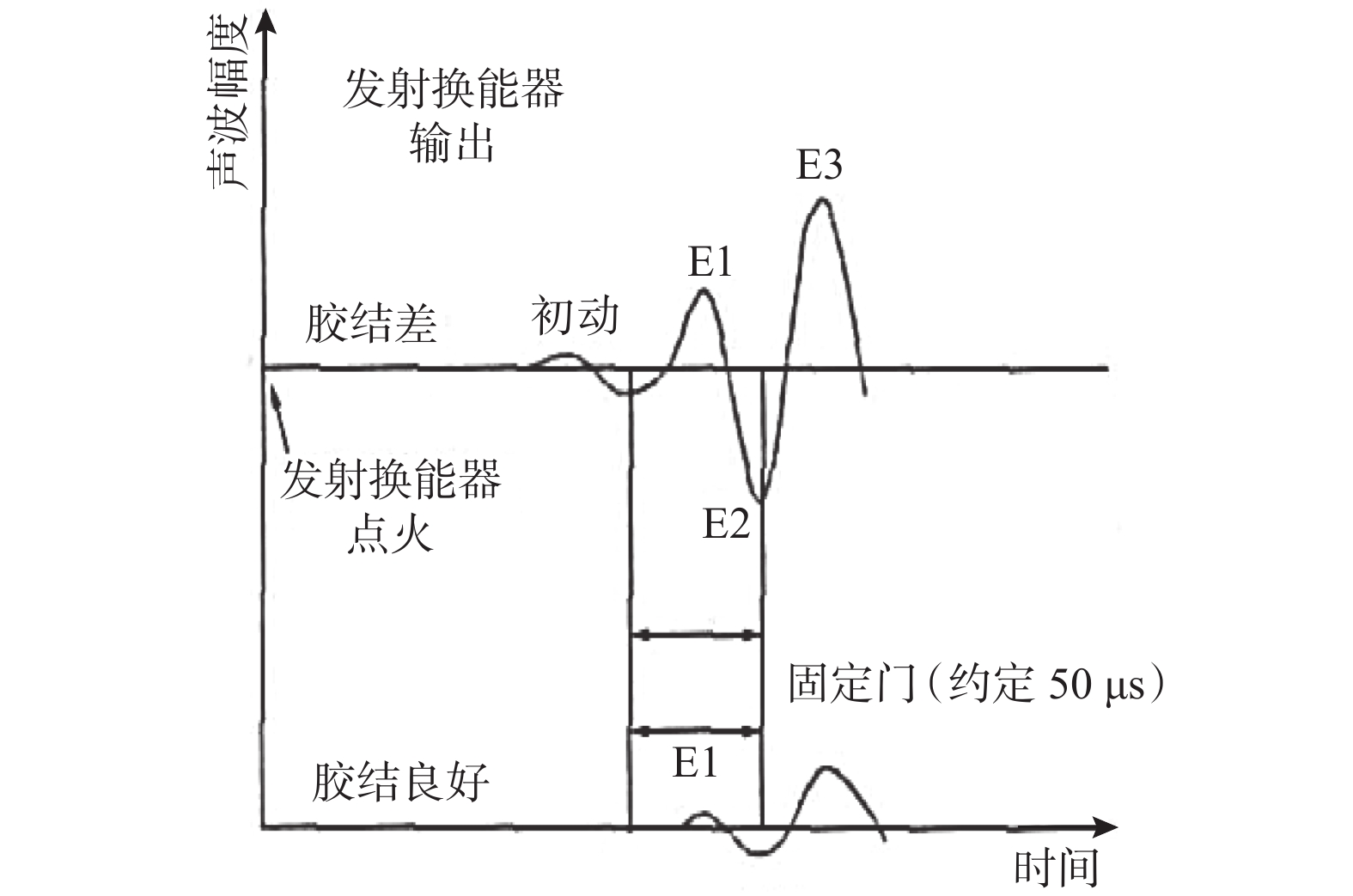
 下载:
下载:
